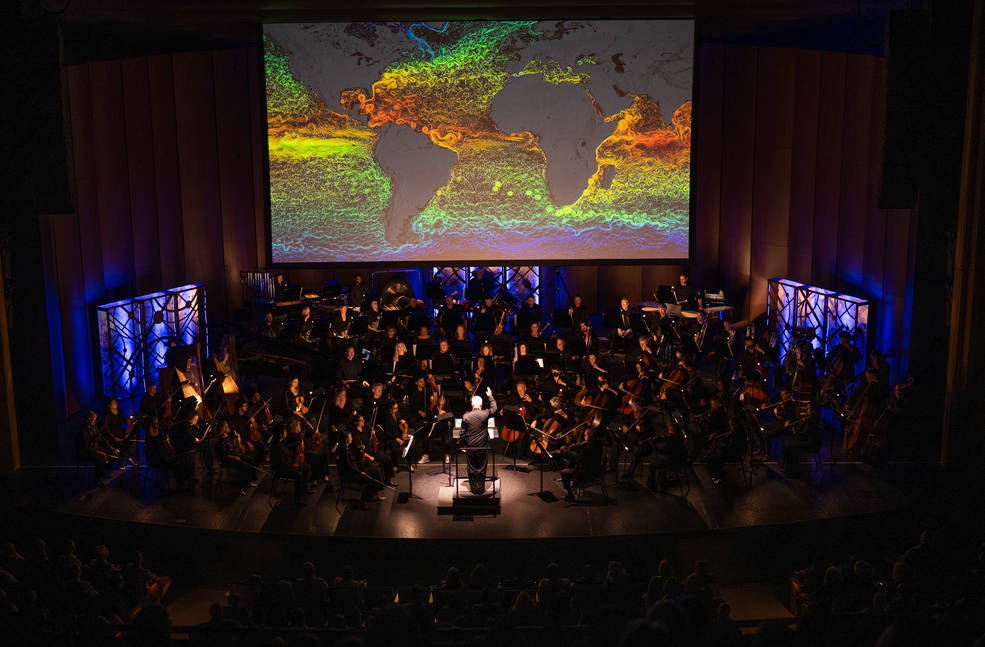
Awe-inspiring NASA visuals combined with the might of a live symphonic orchestra last week in “Cosmic Cycles,” a multimedia collaboration among the agency’s Goddard Space Flight Center in Greenbelt, Maryland, the National Philharmonic, and composer Henry Dehlinger.
“At NASA, part of our charter is to share the results of our missions with the public,” said Wade Sisler, executive producer in Goddard’s Office of Communications. “By collaborating with composers and musicians, we create a vital bridge between the realms of science and imagination. This fusion of space exploration and musical creativity allows us to bring the beauty and mysteries of our universe to life in a way that transcends the boundaries of traditional scientific communication.”
Piotr Gajewski, music director of the National Philharmonic, conceived of the collaboration and brought the idea to Sisler. Gajewski then reached out to Dehlinger to compose new music for the performance: “Cosmic Cycles” was born.
“There are some areas in which we’re pushing the envelope just a little bit,” Dehlinger said. The suite’s final movement, “Echoes of the Big Bang,” showcases imagery from the James Webb Space Telescope and computer models of black holes and colliding stars. Dehlinger added a synthesizer to his instrumentation and used NASA data of a black hole, converted into sound. “It is one of the most spectacularly eerie sounds you will ever experience,” Dehlinger said.
Goddard first collaborated with the National Philharmonic on a performance of Gustav Holst’s “Planets” suite and Debussy’s symphonic poem “La Mer” in 2018. What made “Cosmic Cycles” unique was how the project’s creative process was flipped on its head.
“I wanted to challenge NASA to actually put together videos without any music and let the music come after,” Gajewski said.
What followed was a nearly year-long creative process.
Each of the seven “Cosmic Cycles” movements focuses on a different aspect of space. Using sequences from Goddard’s Scientific Visualization Studio and other NASA groups, video producers Scott Wiessinger – project lead – and David Ladd, James Tralie, Lauren Ward, Ryan Fitzgibbons, and data visualizer Ernie Wright crafted distinctive multimedia pieces for each movement.
Dehlinger used the footage to tailor his musical composition. “There was this endless supply of inspiration.” he said. “It really was wonderful to be able to simply watch the film and then let the music unfold.”
The “Earth as Art” movement of the “Cosmic Cycles” performance featured imagery from Landsat. Starting in 1972, eight Landsat satellites have orbited Earth, taking images of the surface. This unprecedented coverage has been tremendously useful to the scientific community, but it has also produced thousands of beautiful high-resolution images of the complex patterns of our world. From the fractal patterns of mountain ranges and river deltas to the precise geometry of agriculture, Landsat has rendered Earth as a work of art. (Don’t miss the USGS EROS Landsat-based Earth as Art collections. The first collection was released in 2001.)
Dehlinger said he is thrilled for audiences to experience this concert and hopes it connects each person to their presence in the vast universe around us. “I think everyone who was involved in this project not only put their minds into it, but they put their hearts into it,” he said.
“Cosmic Cycles” premiered May 11 at Capital One Hall in Tysons, Virginia, with a repeat performance May 13 at The Music Center at Strathmore in North Bethesda, Maryland. Goddard released a digital version of “Cosmic Cycles” with synthesized orchestra today on YouTube, and HD-quality downloads are available on the Scientific Visualization Studio website.






